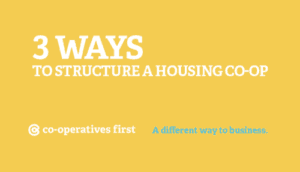There are not enough affordable housing units in Canada, an issue that’s affecting everyone from low-income individuals to first-time home buyers and seniors to college students.
According to the Canada Mortgage and Housing Corporation (CMHC), Canada will need an additional 3.5 million homes by 2030. Housing continues to get less affordable as the average price of a home in Canada rose 6.3% to $668,754 over the past year.
The Government of Canada has committed more than $82 billion to make housing more available and affordable. While the government is providing funds, they’re relying on private businesses, municipalities, and regular people to take the lead on building these new homes.
People need to work together to access this funding and create the housing solutions their communities need, and creating co-ops is a great way to do it. Here are four options that could help you and your community address housing issues using the co-op model.
For-profit Housing Co-op
A for-profit housing co-op (sometimes called equity, or market housing co-ops) offers an alternative to condominiums. With this model, homeowners buy their unit at market values and purchase a membership in the co-op. This model allows first-time home buyers or those looking to downsize to build the value of their asset and get the value of the unit when they sell. For-profit housing co-ops are the preferred model for those creating a co-housing community where members share services and some communal spaces.
Non-profit Housing Co-op
Non-profit housing co-ops are owned by their tenant members, whose rent reflects the true cost of operating the property. This is the most common model of housing co-op in Canada and meets the criteria of major affordable housing funding agencies like CMHC and BC Housing. Most of these co-ops will access some form of government funding to subsidize rents or construction and rely on a mortgage to cover construction costs.
This model offers renters an alternative to their landlord and greater control over decisions that affect their homes. The team at Serenity Housing Co-op is using this model to tackle affordability in British Columbia’s lower mainland.
Community Service Co-op
If your group wants to create housing solutions but isn’t made up of the people who will live in the building, a community service co-op could be the right fit. With many of the same features as a non-profit corporation, a community service co-op is designed to provide charitable services, like homeless shelters, seniors’ housing, or youth programming.
Membership in a community service co-op is open to the public, so anyone can get involved and be part of the solution. Our friends in Southeast Manitoba put this model to work and are well on their way to securing funds for a new seniors’ housing facility.
Community Investment Co-op
Maybe the people in your community who are best placed to solve your housing problem are investors. That was the case in Sangudo, Alberta. The Sangudo Opportunity Development Cooperative pooled money from local investors seeking to financially support local businesses and initiatives. Seeing the lack of quality family homes in their community, the co-op led the construction of two new houses. The sale of these homes contributed to the co-op’s revenue, and when the co-op generated a profit, it issued dividends to members.
How your community approaches housing solutions depends on your local needs, population, and available funds. But most importantly, it depends on the people who are ready to roll up their sleeves and find solutions.
Want to find out more about how you can start a housing co-operative? Check out our webinars, or get in touch.

 Written by
Written by 


